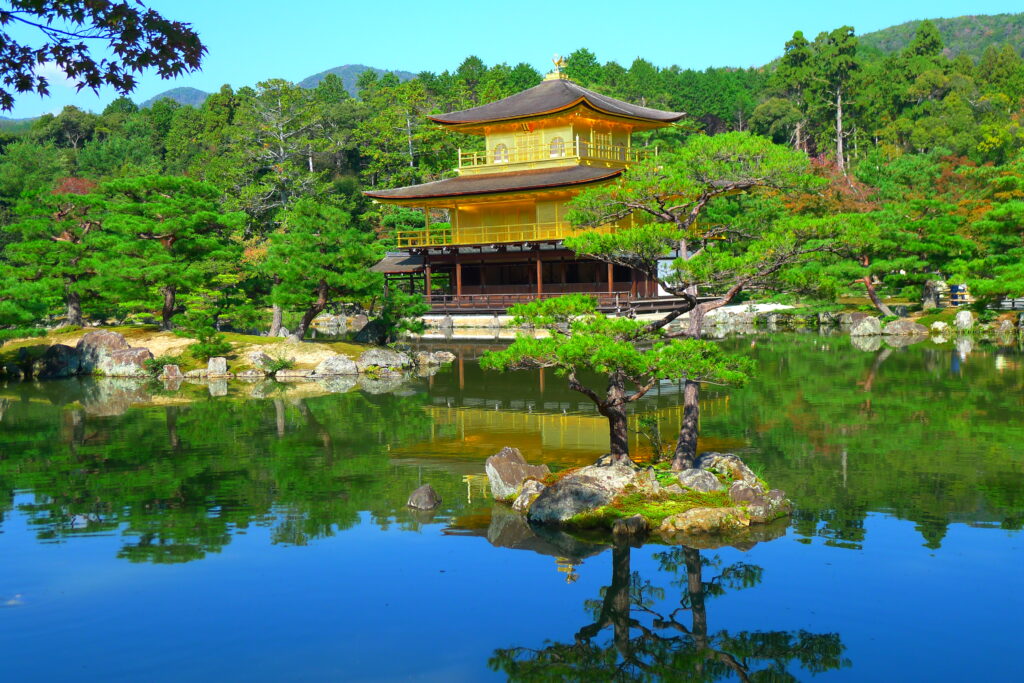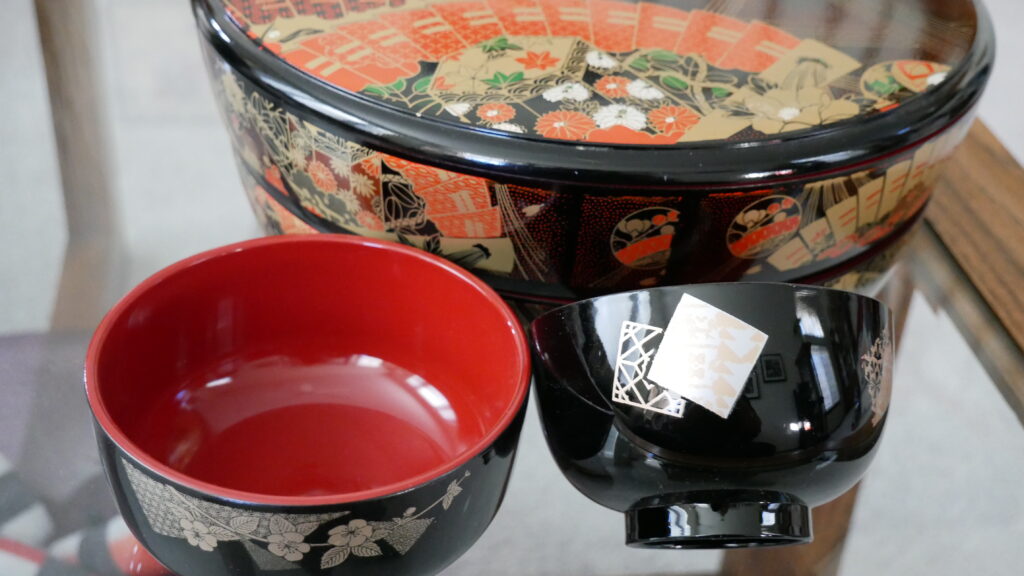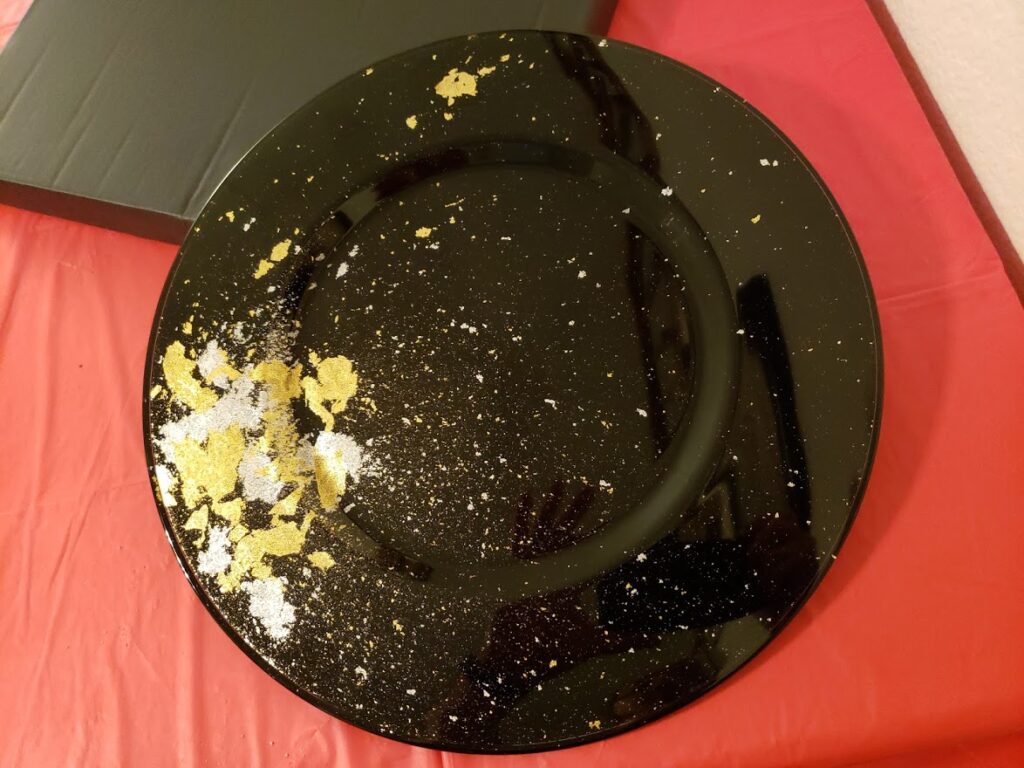
26 Nov Glass plates that are worthy of display as art
(Note: This is a sponsored post.)
If you’ve ever dined at a nice Japanese restaurant, you’ve probably had misoshiru (miso soup) out of a lovely, thin bowl with lacquered fish – maybe red or orange inside, and black outside with an intricate Japanese pattern, probably in gold. Or maybe you’ve had sushi served in a round container with several layers and a beautifully decorated lid, or even an elaborate boat-shaped serving tray.
These items could have been plastic, which is common today, but in a traditional home or restaurant, the bowl would have been made of wood, and the lovely finish would have been Japanese lacquer, called Urushi. It’s used not just for tableware, but also on furniture, art and sculpture, and jewelry.

The most famous and iconic example of urushi lacquer, though most people may not realize it, is Kinkakuji, the world-renown golden temple in Kyoto. Yes, the landmark’s golden surface glows and reflects light in an otherworldly aura is applied with layers of lacquer applied both underneath and over the gold leaf.
Urushi lacquer is an ancient, time-intensive, laborious process that uses the sap of the Urushi, or lacquer, tree that grows in Japan, China and parts of Southeast Asia. The grayish raw sap, which is extracted from cuttings in the bark around the trunk, is poisonous and can cause a reaction like poison ivy. It’s stored for up to five years after being collected, then filtered and homogenized and becomes a transparent varnish that can be colored with minerals for application and is waterproof after application. It’s not just used for tableware but also containers, furnishings and jewelry – even beautiful fountain pens. Kintsugi, the traditional Japanese art of repairing broken ceramicware with gold uses layers of Urushi lacquer to hold the pieces together.
Maki-e, sprinkling or painting gold on Urushi lacquerware to create intricate and elaborate designs, is done using tools including tiny fine brushes and bamboo tubes to blow powder on surfaces then coating it with layers of lacquer, is a 1,500-year-old art form. Urushi is best-known as a finish on wood or ceramics, but it can also be used on glass.

The challenge for producing lacquerware for everyday use here in the US has been durability and deterioration from lack of humidity. In Japan the humid climate is fine for Urushi and lacquerware there has lasted for centuries. But in other parts of the world (Colorado, for example, where I live), the dry air can weaken the coating. And, lacquerware in the past has been susceptible to damage from western cutlery, like knives and forks. They work great when you’re using a spoon or chopsticks.
Syosaku-Japan, a company I’m proud to help promote for its world-class Japanese kitchen knives, offers a collection of glass Urushi lacquerware plates that are both gorgeous and practical for use in the West. I got a charger plate a couple of years ago for my wife Erin as a Christmas present, and it’s a beautiful example of Urushi craftsmanship with its striking splashes of gold leaf and powder over a black background. What’s a charger plate, you ask? A charger plate is a large plate that’s sometimes called an “underplate,” on which a dish can be placed to serve food and eat from. You’ve probably seen the extra plating at a wedding or other fancy banquet, or at a high-class restaurant.
Syosaku-Japan offers different sizes of both charger plates and dinner plates, and they’re all one-of-a-kind Urushi designs with gold and silver on background colors (both solid colors and gradient shades). And Syosaku-Japan has come up with a process that puts Urushi lacquer and the design elements between layers of glass that protects the plates from wear and tear and the elements. The plates are even dishwasher safe.

Because the plates are so strikingly beautiful, we haven’t used them as platters to serve food – we display them on stands. But it’s good to know that I can use the plates like we do our collection of Japanese ceramic dishes and platters – and a couple of older lacquerware sushi serving platters and yes, even a sushi boat that we got from my mom’s house years ago.
Syosaku-Japan has asked if they could name me an “Ambassador” and I’m happy and honored to be featured on their website.
Syosaku is an interesting and modern Japanese provider of excellent knives and glass Urushi lacquerware – they don’t manufacture their products but find craftsmen throughout Japan to source their knives and Urushi plates. They sell to American consumers with warehouses in the US so the shipping is fast (three days) – and FREE in the US. Unlike other companies that claim to sell “Japanese” knives but actually sell knives made in China that might be decent but marketed dishonestly, Syosaku is honest and upfront. Buyers should beware of glitzy online ads that push traditional “Japanese” knives with amazing claims of discount from overinflated retail prices – check the company’s headquarters and make sure they’re in Japan, not elsewhere. And know that certain regions of Japan are best-known for their history of crafting knives, and any company that proudly sells Japanese knives will tout their source.
Syosaku-Japan was founded by Toshi Sekiya, who worked in the Japanese corporate world for years and spent time assigned to Europe, and launched Syosaku in 2017 after returning from overseas and appreciating the traditional arts and crafts of his country, while recognizing the rising interest in Japanese knives, cuisine and culture around the world. I came across Syosaku in 2019 when I returned from a trip to Japan when I unfortunately didn’t have the chance to visit shops in Tokyo and Osaka for kitchen knives I had become interested in. I still wanted a knife so I searched online. I liked what I saw at Syosaku. Toshi-san seeks out artisans from the regions known for their knives and lacquerware, and even though his company is based in Tokyo, it’s a virtual and distributed operation. He’s building his brand online, through his website and social media, thanks to his small (virtual) staff that handles marketing and fulfillment. Like I said, Syosaku is a modern company.
I’m glad I bought my beautiful Santoku knife and then my first Charger Plate from Syosaku, and then contacted Toshi-san to learn more about his company. He did me a great favor after I first chatted with him – I asked if he could sell me a magnolia wood Saya, or sheath for my Santoku but the knife didn’t come with one. After seeing a YouTube video of me playing “Ue O Muite Arukou” (Americans know the song as “Sukiyaki,” the #1 US hit from 1963 by Kyu Sakamoto) at a memory care center and seeing my mother singing along – her memory has suffered greatly from dementia – Toshi-san had a Saya custom-made for me as a tribute to my mom.
That’s the kind of company Syosaku-Japan is – and the kind of entrepreneur Toshi Sekiya is – I like and trust the company because of his, well, Japanese values of commitment to tradition, precision and care.
NOTE: On November 29, Syosaku-Japan is holding a Cyber Monday Sale with some serious discounts and sale prices — all Urushi plates 50% off, and selected knives up to 50% off. They’ll also have “Wheel of Fortune” chances to receive deeper discounts during the day. Visit my Ambassador page and then click around the Syosaku website from there. Full disclosure: As an “Ambassador,” I get a small commission from sales. I’ve been featuring my Santoku knife which I bought from Syosaku-Japan as well as their beautiful Urushi glass plates in my foodporn social media posts for the past two years before I became and affiliate/ambassador, and honestly love their products and the company’s attention to customer service.



